


Table of Contents
Round One – Peter Dimond's Treatise:
Their Direct Case Cross-Examined:
What About the What-Abouts? – The Defense of BOB and BOD:
Concluding Round One with Closing Arguments:
Round Two – Fr. Feeney Himself and All the Rest:
Installment Sixteen and beyond – to be supplied...
About sixty years ago, the Saint Benedict's Center, a lay organization located near Boston College and having the then-already-famous Fr. Leonard Feeney as its Spiritual Director, made national news with its declaration to the effect that the Archbishop of Boston was a heretic. Right away, camps formed, both "for" and "against," arguments were laid out, Popes, Councils, Ancient Fathers, Church Doctors, and others were rounded up as sources, and yet the question remained. In sixty years since that time, coercive Church disciplines, accompanied by only a smattering of magazine articles, slim volumes, and the occasional single chapter out of a much larger book mostly about other topics, have been the only response made to the claims of the Saint Benedict's Center. We knew they were wrong, but no one seemed willing or able to go through their "case" at length and in detail so as to show exactly where and how it was wrong.
While those abbreviated responses have certainly been sufficient to dissuade those who are still considering Fr. Feeney's position, the fact remains that they have all proven ineffective with any of the more inculcated members and followers. Even here, anyone who is not committed to his teachings could be equally dissuaded by the reading of any half-dozen or so "Installments" from this work. So one may wonder, why the extreme length? To those who have been inculcated in depth into Fr. Feeney's teaching but who are not the inventors of it and believe it in all sincerity, my word to you is that you have been lied to. This work is designed to expose the full extent and thoroughness of that deception to which you have been victim. I certainly do hope to gain even those who have been long hardened into Fr. Feeney's position and who may even now as they read this introduction believe that there is nothing that I can say to prove his teaching wrong, so long as they are sincere and capable of reading and understanding it at all.
Also, even those who might have been persuaded by some any half-dozen or so "Installments" of this work might always wonder about the many arguments and authoritative quotations that go unanswered in what shorter works one encounters. As long as anything remains unrefuted there remains in that some basis for some niggling suspicion that maybe Fr. Feeney might have been right after all. While showing that any particular argument, case, or proponent of a position is dishonest may be sufficient for proving it invalid, that is not the same thing as proving the whole position to be wrong. There is also the matter of righting the injustice done to many Fathers, Doctors, Popes, and Theologians whose writings have been gravely ill-used by Fr. Feeney and his cohorts as to be made to seem as if they either never heard of Baptism of Desire (or even of Blood in some cases) or else actually opposed those teachings. In this work, they have been given a chance to speak for themselves at length about what their actual position is with regards to these teachings. The goal here has therefore been to cover all the bases, to dismantle all the intellectual subterfuges and scholastic dishonesty used by Fr. Feeney and his followers from then up to now, until none of it remains. This has never been done before.
For sixty years, Fr. Feeney and his followers saw this lack of a comprehensive and scholarly response as some sort of vindication. It is now time for that to come to an end. This volume ends it. I accuse Father Leonard Feeney, and his associates and subsequent followers, both those who were closely associated with the original St. Benedict's Center and subsequent Slaves of the Immaculate Heart of Mary, as well as those more loosely or distantly associated who have arisen since, of the academic crime of scholastic dishonesty. The expression "scholastic dishonesty" here is used to refer to a most diabolical misuse or abuse or misrepresentation of the scholastic sources in support of erroneous (or perhaps even heretical) claims which have no legitimate basis in those sources.
While this study is principally drawn from the standard theological sources upon which the Magisterium is based, occasionally more recent sources directly addressing this question are brought into the discussion at times. It will be noted that some of these contemporary sources whose arguments, either for or against, that I have discussed herein are from "traditionalist" writers, some from the Society of Saint Pius X (SSPX), and others even from more extremely situated traditionalist priests and orders. There are several reasons this should be so.
For one, I am a "traditionalist" myself, and as such quite familiar with their writings. However, I perceive that the doctrinal denials taught by Fr. Feeney and his cohorts and successors have become something of a pastoral problem extending well beyond merely our "traditionalist" chapels and communities. In recent times, this problem has even merited responses from Karl Keating's "This Rock" apologetics publishing group, and EWTN, as well as other writers drawing from the contemporary "mainstream." It has even extended to some few Protestant groups, though for them only the Scriptural arguments would be of relevance. Therefore, though myself a "traditionalist," I write this book to, and for the benefit of, all Catholics, not only "traditionalist" but also "conservative" and "liberal" alike, and everything in between. And perhaps even some Protestants could find some points herein to be of interest.
For another, there is little room to deny that "traditionalist" writers in general tend to be frequently concerned specifically about doctrine, about preserving the ancient doctrines and dogmas as fully and accurately as possible, though of course many others share this concern as well, most notably the apologetic and conservative groups mentioned above. Nevertheless, because of this, despite the fact that the "traditionalist" community is something like between two and three orders of magnitude smaller than that of the non-traditionalists, the total number and amount of writings in response to this Fr. Feeney issue from each of these two categories (since the time that any distinction between "traditionalist" and not arose) are at near parity with each other, not counting this current work.
And finally, it is because the followers of Fr. Feeney have a far stronger presence among the "traditionalist" chapels and communities. This seems to be so owing to some several parallels existing between the Feeney followers and the "traditionalist" community. Both are concerned that overly generous and liberal interpretations of Catholic teaching might obviate the need for the Church by making salvation seem easily obtainable without it. Both have a fondness or devotion to the "old ways" of doing things, for example using the Latin Mass. Both see the loss of clarity and definition within the Church as an explanation for the widespread loss of faith and devotion, and for the loss of order and morals in the world at large. And most of all, both have endured similar circumstances of being "on the outs" with the Vatican at one time or another, with some groups of each continuing thus to this day. Predictably, these shared concerns and experiences will tend to engender a certain natural sympathy between the two groups and encourage the followers of Fr. Feeney to seek out the venues for traditional Catholicism, at the very least for their Sacraments, and often as their chief proselytizing grounds as well.
It is also to be noted that the first and larger part of this response is devoted, not to any writing of Fr. Feeney himself, but to one of his current, but less direct followers, namely one Peter Dimond, who wrote a 335-page Treatise titled, "Outside the Catholic Church There is Absolutely No Salvation." I start here, rather than with any of Fr. Feeney's writings, for several reasons. For one, it was this that occasioned a friend's sojourn with that camp, and which he found to be by far the most persuasive. For another, I have found it quite comprehensive and detailed, and with one notable exception (namely, how certain statements from the Council of Trent are to be interpreted), quite representative of what Fr. Feeney and writers of his kind in general teach, and the sources they use and the way they use them. Finally, Peter Dimond's Treatise expounds his claims quite clearly and with very little of the internal self-contradiction or hesitancy that pervades Fr. Feeney's own writings and those of his much closer cohorts.
Therefore, there is certain appropriateness to having this definitive response to Fr. Feeney come from a "traditionalist" Catholic and address first and in most detail a "traditionalist" follower of Fr. Feeney. It is not however any "traditionalist" bias that accounts for the relative dearth of references to non-traditionalist responses, but rather a certain aspect of literary or scholastic "challenge." There is no room to doubt that Vatican II and the official declarations published since contain much that flat-out denies or refutes the teachings and whole outlook of Fr. Feeney. And many of the non-traditionalist responses base themselves on this rather trivial and easy finding, and as such may be rather unconvincing to some, and to others merely suggestive of the claim that Vatican II really did change doctrines. Both traditionalists on the one hand, and liberals on the other, see the Council as having changed things quite a bit regarding the possibilities of salvation for non-Catholics, the difference being that the second group are happy with the changes they see in it whereas the first are not. Even conservatives, who see the Council as not having changed anything so crucial, would have to admit that the Council brought out much to deny or refute Fr. Feeney that hadn't been brought out before.
The far more interesting and relevant question is whether or not a convincing response to Fr. Feeney's teaching can be found within the pre-Vatican II sources. This is helpful for two reasons, one being for the benefit of certain traditionalists who do not trust the Council, but who will and must trust the pre-Vatican II sources. The other reason however is that by doing this it turns attention away from the question of whether Vatican II really changed anything or not. For that is only one of any number of other related questions, for example as to what to make of the recent and current Vatican leadership, canonically speaking, and whether the new Mass is valid, and so on that are questions which are by their very nature and by my choice here, utterly outside the scope of this book. It is my goal that if this book were the only writing of mine to survive, then even a most careful reading of it (not including this Introduction) would leave the reader clueless as to my thoughts on those other sorts of questions.
I accomplish this by focusing simply and exclusively on the one single issue that Fr. Feeney and his cohorts and more distant followers all raise: Is it possible for a soul to be saved under the terms of the New Covenant, at least within some certain circumstances, without having been baptized actually and literally with water? Fr. Feeney says no. I say yes. It is of course for the body of this work to make the case for the claim that the Church has also always said yes. This work was originally published serially on the internet in a format of "Installments" initially published weekly, but as the installments became longer their initial publication became more sporadic. In time my editor began breaking up my installments into two or three separate parts to keep the length of individual parts more manageable. To preserve the freshness and vigor of the work, their original published format is retained herein. The first subtitle link for each Installment is a descriptive one meant to convey its basic subject matter and which goes straight to the article; the second link is the title given it as originally published on the Internet and which goes to the Editor's introductory blurb for the installment.
 When words are omitted or added they can alter the entire message. This has been a favorite trick of satan for eons, especially with the diverse and intentional interpretations forged by multi-thousands of Protestant sects.
When words are omitted or added they can alter the entire message. This has been a favorite trick of satan for eons, especially with the diverse and intentional interpretations forged by multi-thousands of Protestant sects.
  Griff Ruby begins a comprehensive series in which he must do what St. Paul entreats in 2 Timothy 4: 2-5 and to be faithful to the word and what holy Mother Church teaches in accordance with the Apostle's words in Galatians 1: 8-10. They say sticks and stones can break bones, but names will never hurt, however words can hurt souls when they are deceived and it has been done for ages by those who are hellbent on cramming square pegs into round holes. It is how the Arian heresy gained such prominence; how Luther altered Christian belief to apostasize from the true Church and take billions since with him; how one side has forced their ideology on others by twisting words and meaning to indicate something totally different than the authority conveying said words intended. This intentional twisting is done all the time and it is wrong. With that in mind, this first installment in this series "The Art of Scholastic Dishonesty" revs up with some obvious dishonesty in Sacred Scripture that has resulted in a chaotic array of over 34,000 sects that have apostasized from Christ's True Church. Griff deciphers the differences and how one can tell so clearly what is true and what is slanted to deceive as he points out in installment one, Word Twisting to Change the Meaning
Griff Ruby begins a comprehensive series in which he must do what St. Paul entreats in 2 Timothy 4: 2-5 and to be faithful to the word and what holy Mother Church teaches in accordance with the Apostle's words in Galatians 1: 8-10. They say sticks and stones can break bones, but names will never hurt, however words can hurt souls when they are deceived and it has been done for ages by those who are hellbent on cramming square pegs into round holes. It is how the Arian heresy gained such prominence; how Luther altered Christian belief to apostasize from the true Church and take billions since with him; how one side has forced their ideology on others by twisting words and meaning to indicate something totally different than the authority conveying said words intended. This intentional twisting is done all the time and it is wrong. With that in mind, this first installment in this series "The Art of Scholastic Dishonesty" revs up with some obvious dishonesty in Sacred Scripture that has resulted in a chaotic array of over 34,000 sects that have apostasized from Christ's True Church. Griff deciphers the differences and how one can tell so clearly what is true and what is slanted to deceive as he points out in installment one, Word Twisting to Change the Meaning
 In defending the treasure of the Sacred Deposit of the Faith, one must glean the gems that are presented to verify the authenticity and veracity of what they reflect in the prisms of polemics.
In defending the treasure of the Sacred Deposit of the Faith, one must glean the gems that are presented to verify the authenticity and veracity of what they reflect in the prisms of polemics.
   Griff Ruby continues his comprehensive series in which he must do what St. Paul entreats in 2 Timothy 4: 2-5 and to be faithful to the word and what holy Mother Church teaches in accordance with the Apostle's words in Galatians 1: 8-10. In an effort not to mix metaphors, but to mine for the gems the Church has always held sacrosanct as divine truth, we hold a Ruby up to a Dimond to show the obvious imperfections in the latter's seemingly brilliant refractions of promoting Feeneyism. However, when looking closer one can see the gaps in the quartz that make its claim to being reliable totally bogus and extremely harmful to the investment of souls. The Extra Ecclesiae Nulla Salus dogmatic argument stands true as always, but the denial of Baptism of Blood and Baptism of Desire holds no light in the spectrum of the Communion of Saints and, does, in fact, dull the senses and leads to grave error and a serious detriment to unity within the Traditional Catholic movement. To understand how an omission can easily be a commission of error, see Part Two Ellipses can Eclipse Ecclesial Intent
Griff Ruby continues his comprehensive series in which he must do what St. Paul entreats in 2 Timothy 4: 2-5 and to be faithful to the word and what holy Mother Church teaches in accordance with the Apostle's words in Galatians 1: 8-10. In an effort not to mix metaphors, but to mine for the gems the Church has always held sacrosanct as divine truth, we hold a Ruby up to a Dimond to show the obvious imperfections in the latter's seemingly brilliant refractions of promoting Feeneyism. However, when looking closer one can see the gaps in the quartz that make its claim to being reliable totally bogus and extremely harmful to the investment of souls. The Extra Ecclesiae Nulla Salus dogmatic argument stands true as always, but the denial of Baptism of Blood and Baptism of Desire holds no light in the spectrum of the Communion of Saints and, does, in fact, dull the senses and leads to grave error and a serious detriment to unity within the Traditional Catholic movement. To understand how an omission can easily be a commission of error, see Part Two Ellipses can Eclipse Ecclesial Intent
 When speaking in terms of "One", we have to keep in mind those Catholic truths that certain Entities are "Three in One" such as the Holy Trinity, the Communion of Saints and Baptism.
When speaking in terms of "One", we have to keep in mind those Catholic truths that certain Entities are "Three in One" such as the Holy Trinity, the Communion of Saints and Baptism.
 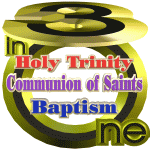 Griff Ruby continues his comprehensive series "The Art of Scholastic Dishonesty" for he realizes the responsibility to educate, inform and rebuke as St. Paul entreats in 2 Timothy 4: 2-5 and to be faithful to the Word and what holy Mother Church teaches and to be on guard for what the Apostle warns in Galatians 1: 8-10. There is but One God, One Church, One Baptism but within One God is Three Persons, Father, Son and Holy Ghost; and within One Church the church Militant, Church Suffering and Church Triumphant; and, keeping in mind God's Communion of Saints there is within One Baptism the Baptism of Water alone for the Church Militant on earth, but there is also the Baptism of Blood and/or the Baptism of Desire for those who would, through their death, become members of the Church Suffering or Church Triumphant, Purgatory and Heaven respectively. The "Three in One" application preserves and strengthens the First Dogma of the Church that there is no salvation outside the Church (Extra Ecclesiam Nulla Salus) because those receiving BOB or BOD would be in the Church, not outside. This is something that such luminaries as Peter Abélard, Fr. Leonard Feeney, S.J. and radical Peter Dimond did not or do not honestly admit. Maybe that's why the idiom applies so aptly to such 'intellectuals' as these: A small amount of knowledge can cause people to think they are more expert than they really are. In other words, as has been proven by their condemnation by holy Mother the Church: a little knowledge can be a dangerous thing! Griff explains in Part Three Three who dare challenge Church Teaching
Griff Ruby continues his comprehensive series "The Art of Scholastic Dishonesty" for he realizes the responsibility to educate, inform and rebuke as St. Paul entreats in 2 Timothy 4: 2-5 and to be faithful to the Word and what holy Mother Church teaches and to be on guard for what the Apostle warns in Galatians 1: 8-10. There is but One God, One Church, One Baptism but within One God is Three Persons, Father, Son and Holy Ghost; and within One Church the church Militant, Church Suffering and Church Triumphant; and, keeping in mind God's Communion of Saints there is within One Baptism the Baptism of Water alone for the Church Militant on earth, but there is also the Baptism of Blood and/or the Baptism of Desire for those who would, through their death, become members of the Church Suffering or Church Triumphant, Purgatory and Heaven respectively. The "Three in One" application preserves and strengthens the First Dogma of the Church that there is no salvation outside the Church (Extra Ecclesiam Nulla Salus) because those receiving BOB or BOD would be in the Church, not outside. This is something that such luminaries as Peter Abélard, Fr. Leonard Feeney, S.J. and radical Peter Dimond did not or do not honestly admit. Maybe that's why the idiom applies so aptly to such 'intellectuals' as these: A small amount of knowledge can cause people to think they are more expert than they really are. In other words, as has been proven by their condemnation by holy Mother the Church: a little knowledge can be a dangerous thing! Griff explains in Part Three Three who dare challenge Church Teaching
 The depositions of quotes in Dimond's Treatise reek of being taken out of context, thus twisting the meaning for the Prosecution against Baptism of Blood and Baptism of Desire, but Griff stands in for the Defense, keeping everything in context in proving that the Means will justify his arguments.
The depositions of quotes in Dimond's Treatise reek of being taken out of context, thus twisting the meaning for the Prosecution against Baptism of Blood and Baptism of Desire, but Griff stands in for the Defense, keeping everything in context in proving that the Means will justify his arguments.
 Griff Ruby continues his comprehensive series "The Art of Scholastic Dishonesty" with his fourth installment that is most necessary for Catholics to understand one's responsibility to educate, inform and rebuke as St. Paul entreats in 2 Timothy 4: 2-5 and to be faithful to the Word and what holy Mother Church teaches and to be on guard for what the Apostle warns in Galatians 1: 8-11. The tomes of quotes by Peter Dimond in his supposedly "air-tight" arguments in his Treatise
Griff Ruby continues his comprehensive series "The Art of Scholastic Dishonesty" with his fourth installment that is most necessary for Catholics to understand one's responsibility to educate, inform and rebuke as St. Paul entreats in 2 Timothy 4: 2-5 and to be faithful to the Word and what holy Mother Church teaches and to be on guard for what the Apostle warns in Galatians 1: 8-11. The tomes of quotes by Peter Dimond in his supposedly "air-tight" arguments in his Treatise have more holes than Swiss cheese. Once readers discover his dishonesty of omitting key components that actually quite often refute his forced and faulty conclusions, they should smell what's really intended. And once readers clearly understand his deliberate deception of placing misdirected emphasis on the words of Fathers, Doctors, Saints and Popes of the Church in his Treatise to forge a different conclusion, then readers should begin to understand only too well where that putrid stench originated. Griff fumigates more of the mephetic MHFM's misrepresentations in Part Four The Treatise is in Contempt of Context have more holes than Swiss cheese. Once readers discover his dishonesty of omitting key components that actually quite often refute his forced and faulty conclusions, they should smell what's really intended. And once readers clearly understand his deliberate deception of placing misdirected emphasis on the words of Fathers, Doctors, Saints and Popes of the Church in his Treatise to forge a different conclusion, then readers should begin to understand only too well where that putrid stench originated. Griff fumigates more of the mephetic MHFM's misrepresentations in Part Four The Treatise is in Contempt of Context
 Taking quotes out of context is a favorite tactic of those who master in misdirection and misrepresent themselves to others as to their knowledge of theology and Catholic doctrine. If it's a case of "invincible ignorance" than they're dumber than we've given them credit for. Of course, considering the plethora of doctrinal documentation available, we know such is impossible today. Therefore, it has to be deliberate deception for they do know better and that makes it all the more tragic for theirs and their followers' salvation.
Taking quotes out of context is a favorite tactic of those who master in misdirection and misrepresent themselves to others as to their knowledge of theology and Catholic doctrine. If it's a case of "invincible ignorance" than they're dumber than we've given them credit for. Of course, considering the plethora of doctrinal documentation available, we know such is impossible today. Therefore, it has to be deliberate deception for they do know better and that makes it all the more tragic for theirs and their followers' salvation.
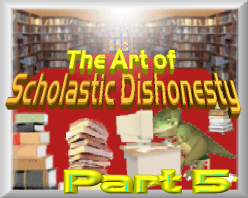 Griff Ruby continues his comprehensive series "The Art of Scholastic Dishonesty" with his fifth installment that is most necessary for Catholics to understand one's responsibility to educate, inform and rebuke as St. Paul entreats in 2 Timothy 4: 2-5 and to be faithful to the Word and what holy Mother Church teaches and to be on guard for what the Apostle warns in Galatians 1: 8-11. The tomes of quotes by Peter Dimond in his supposedly "air-tight" arguments in his Treatise The erosion of truth from the tomes of quotes by Peter Dimond in his weighty wordage (as in poundage, not clarity and truth) leads one to assume the agenda Dimond and Feeneyites are trying to ramrod down people's throats could be correct
Griff Ruby continues his comprehensive series "The Art of Scholastic Dishonesty" with his fifth installment that is most necessary for Catholics to understand one's responsibility to educate, inform and rebuke as St. Paul entreats in 2 Timothy 4: 2-5 and to be faithful to the Word and what holy Mother Church teaches and to be on guard for what the Apostle warns in Galatians 1: 8-11. The tomes of quotes by Peter Dimond in his supposedly "air-tight" arguments in his Treatise The erosion of truth from the tomes of quotes by Peter Dimond in his weighty wordage (as in poundage, not clarity and truth) leads one to assume the agenda Dimond and Feeneyites are trying to ramrod down people's throats could be correct  except for one very important canard that Griff exposes: that those being quoted, for the most part, never had the same intention Dimond's using is his miasma of misdirection. But, as Griff points out, Dimond's rationale whenever his "smoking gun" backfires is to blame God! Griff provides the empty casing shells left by the Treatise to prove not only how far off target the Feeneyites are, but that Dimond's been shooting blanks. Griff provides the proof in Part Five What About the What-Abouts? except for one very important canard that Griff exposes: that those being quoted, for the most part, never had the same intention Dimond's using is his miasma of misdirection. But, as Griff points out, Dimond's rationale whenever his "smoking gun" backfires is to blame God! Griff provides the empty casing shells left by the Treatise to prove not only how far off target the Feeneyites are, but that Dimond's been shooting blanks. Griff provides the proof in Part Five What About the What-Abouts?
 For a long time many have suspected the author of the Treatise has lost his marbles. It's a fact he's left some out of the bag, which proves he's not playing fair.
For a long time many have suspected the author of the Treatise has lost his marbles. It's a fact he's left some out of the bag, which proves he's not playing fair.
  Griff Ruby completes the first round with his sixth installment of a mega-part comprehensive series "The Art of Scholastic Dishonesty" in exposing not only the heresy of Feeneyism, but also the intended deliberate dishonest deception of this heresy's defender, most notably one Peter Dimond whose moral compass has taken him dangerously off course. Some might think he's lost his marbles by playing loose and fast with the doctrinal game. However, Catholic truth is always rock solid as marble and the true Church never lags whether the match involves the aggies and steelies of the great Fathers and Doctors that plunked Arianism and Pelagianism, or the Rosary-beaded puries and onyx orbs that targeted Albigensianism, or knuckling down with the flints and alabaster milkies of Trent to strike out of the circle the ducks of Protestantism, Calvinism and every other ism that was introduced in the teen centuries, or the cats-eyes and micas that shoot at the overwhelming heresies so prevalent today in the counterfeit church of conciliarism, including one not affiliated with such, but nevertheless still an obstacle in the direct line: pitching against the fudging Feeneyites. Griff provides clear evidence that the author of the Treatise has been shooting in the dark, taking great liberties in his personal "interpretations" of papal decrees and statements of Saints, Doctors, and sincere Catholic luminaries of the Church. The end result is deliberate deception and proof he's refused to knuckle down to the truth of BOB/BOD. Griff provides the clear evidence in Part Six, It's All or Nothing!
Griff Ruby completes the first round with his sixth installment of a mega-part comprehensive series "The Art of Scholastic Dishonesty" in exposing not only the heresy of Feeneyism, but also the intended deliberate dishonest deception of this heresy's defender, most notably one Peter Dimond whose moral compass has taken him dangerously off course. Some might think he's lost his marbles by playing loose and fast with the doctrinal game. However, Catholic truth is always rock solid as marble and the true Church never lags whether the match involves the aggies and steelies of the great Fathers and Doctors that plunked Arianism and Pelagianism, or the Rosary-beaded puries and onyx orbs that targeted Albigensianism, or knuckling down with the flints and alabaster milkies of Trent to strike out of the circle the ducks of Protestantism, Calvinism and every other ism that was introduced in the teen centuries, or the cats-eyes and micas that shoot at the overwhelming heresies so prevalent today in the counterfeit church of conciliarism, including one not affiliated with such, but nevertheless still an obstacle in the direct line: pitching against the fudging Feeneyites. Griff provides clear evidence that the author of the Treatise has been shooting in the dark, taking great liberties in his personal "interpretations" of papal decrees and statements of Saints, Doctors, and sincere Catholic luminaries of the Church. The end result is deliberate deception and proof he's refused to knuckle down to the truth of BOB/BOD. Griff provides the clear evidence in Part Six, It's All or Nothing!

 It can definitely be dangerous to one's spiritual health if one does not follow the Doctors' advice, especially one so esteemed as the Angelic Doctor. But to deliberately forge St. Thomas Aquinas' medicinal manual for the soul - the Summa, well that can be criminal. It can definitely be dangerous to one's spiritual health if one does not follow the Doctors' advice, especially one so esteemed as the Angelic Doctor. But to deliberately forge St. Thomas Aquinas' medicinal manual for the soul - the Summa, well that can be criminal.
 Griff Ruby resumes his mega-part comprehensive series "The Art of Scholastic Dishonesty" in exposing not only the heresy of Feeneyism, but also the intended deliberate dishonest deception of this heresy's defender, most notably one Peter Dimond, half of the combination known as the Dimond brothers. This week Griff pits them against seven Doctors of the Church. No contest. And yet one would ask, how dare two self-taught pipsqueaks from podunk think they know more than St. Thomas Aquinas by not only doubting, but misinterpreting his masterful Summa Theologica. Not to mention their audacity of calling other holy Doctors of the Church wrong while asserting they themselves - the almighty Dimond brothers - the only ones who are right. Of course, the latter consider themselves self-appointed gods who relish sitting in judgment of one and all whether that be many revered, and proven holy Doctors of the Church or present Traditional Catholic authorities as well as writers of good will who dare challenge their audacity. It's always been a practice that if you might disagree with your doctor, it wouldn't hurt to go to another for a second opinion, or even, rarely, a third. But by the time seven Doctors have all told you the same thing it's time to listen to your Doctor and humbly swallow that bitter pill of truth and accept that your Doctor knows more than you do. In his seventh installment, Griff provides what the Doctors have prescribed and The Evidence is Overwhelming
Griff Ruby resumes his mega-part comprehensive series "The Art of Scholastic Dishonesty" in exposing not only the heresy of Feeneyism, but also the intended deliberate dishonest deception of this heresy's defender, most notably one Peter Dimond, half of the combination known as the Dimond brothers. This week Griff pits them against seven Doctors of the Church. No contest. And yet one would ask, how dare two self-taught pipsqueaks from podunk think they know more than St. Thomas Aquinas by not only doubting, but misinterpreting his masterful Summa Theologica. Not to mention their audacity of calling other holy Doctors of the Church wrong while asserting they themselves - the almighty Dimond brothers - the only ones who are right. Of course, the latter consider themselves self-appointed gods who relish sitting in judgment of one and all whether that be many revered, and proven holy Doctors of the Church or present Traditional Catholic authorities as well as writers of good will who dare challenge their audacity. It's always been a practice that if you might disagree with your doctor, it wouldn't hurt to go to another for a second opinion, or even, rarely, a third. But by the time seven Doctors have all told you the same thing it's time to listen to your Doctor and humbly swallow that bitter pill of truth and accept that your Doctor knows more than you do. In his seventh installment, Griff provides what the Doctors have prescribed and The Evidence is Overwhelming
 Excuses are a dime a dozen and illustrate a lack of confidence in one's arguments, but the Feeneyites' excuse that it's all God's fault takes the cake for absurdity.
Excuses are a dime a dozen and illustrate a lack of confidence in one's arguments, but the Feeneyites' excuse that it's all God's fault takes the cake for absurdity.
 Griff Ruby continues his mega-part comprehensive series "The Art of Scholastic Dishonesty" in exposing not only the heresy of Feeneyism, but also the intended deliberate dishonest deception of this of one of this heresy's greatest defenders, one Peter Dimond, half of the combination known as the Dimond brothers. There are a plethora of excuses Peter Dimond desperately drums up in his Treatise and elsewhere to deflect the obvious in his stubborn pridefulness to cling to the dangling thread of denying Baptism of Desire and Baptism of Blood. Does he not realize that once it completely unravels he'll be completely separated from the vine? Completely "outside the Church" via heresy in the same manner the man he defends was excommunicated by a true pope. The only thing allowing Dimond to spew his rubbish today is that there has been an absence of
Griff Ruby continues his mega-part comprehensive series "The Art of Scholastic Dishonesty" in exposing not only the heresy of Feeneyism, but also the intended deliberate dishonest deception of this of one of this heresy's greatest defenders, one Peter Dimond, half of the combination known as the Dimond brothers. There are a plethora of excuses Peter Dimond desperately drums up in his Treatise and elsewhere to deflect the obvious in his stubborn pridefulness to cling to the dangling thread of denying Baptism of Desire and Baptism of Blood. Does he not realize that once it completely unravels he'll be completely separated from the vine? Completely "outside the Church" via heresy in the same manner the man he defends was excommunicated by a true pope. The only thing allowing Dimond to spew his rubbish today is that there has been an absence of 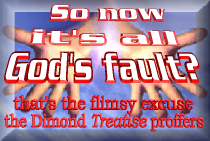 any papal intervention in doctrinal affairs. Regardless, holy Mother Church has wisely prepared for just this and states such in her legitimate Councils, papal decrees and Canon Law: Latae sententiae. In other words by one's persistent deeds or words or actions that contradict Catholic truth, one has separated oneself from the Church. There is no necessity for a pope to decree such, for it still stands in the eyes of God. But to Dimond it's all in the predestined cards and therefore it has to be God's fault that His Church accepts BOB and BOD. Griff points out this gaffe in his eighth installment, When all else fails, blame God! any papal intervention in doctrinal affairs. Regardless, holy Mother Church has wisely prepared for just this and states such in her legitimate Councils, papal decrees and Canon Law: Latae sententiae. In other words by one's persistent deeds or words or actions that contradict Catholic truth, one has separated oneself from the Church. There is no necessity for a pope to decree such, for it still stands in the eyes of God. But to Dimond it's all in the predestined cards and therefore it has to be God's fault that His Church accepts BOB and BOD. Griff points out this gaffe in his eighth installment, When all else fails, blame God!
 Who are you to believe? Those who appoint themselves as self-proclaimed "experts" or authentic Church-authorized experts in the person of Fathers, Doctors, Saints and Popes? If you're honest, it's a no brainer. If you're not honest, you go mining for useful-sounding quotes. It is the epitome of the Art of Scholastic Dishonesty.
Who are you to believe? Those who appoint themselves as self-proclaimed "experts" or authentic Church-authorized experts in the person of Fathers, Doctors, Saints and Popes? If you're honest, it's a no brainer. If you're not honest, you go mining for useful-sounding quotes. It is the epitome of the Art of Scholastic Dishonesty.
 Griff Ruby continues his mega-part comprehensive series "The Art of Scholastic Dishonesty" in exposing not only the heresy of Feeneyism, but also the intended deliberate dishonest deception of this of one of this heresy's greatest defenders, one Peter Dimond, half of the combination known as the Dimond brothers. We've all seen the hilarious exercise of bobbing for apples, ironically in water. However, what Griff has decided to do is not funny, but very necessary in order to refute the heresy of Feeneyism that Baptism by water is the only way to salvation. Thus he goes bobbing for verified examples of Baptism of Blood by first splashing around the depths of the Treatise to uncover the disguised examples that the Dimonds have omitted or fabricated what might have occurred without their ever being there.
Griff Ruby continues his mega-part comprehensive series "The Art of Scholastic Dishonesty" in exposing not only the heresy of Feeneyism, but also the intended deliberate dishonest deception of this of one of this heresy's greatest defenders, one Peter Dimond, half of the combination known as the Dimond brothers. We've all seen the hilarious exercise of bobbing for apples, ironically in water. However, what Griff has decided to do is not funny, but very necessary in order to refute the heresy of Feeneyism that Baptism by water is the only way to salvation. Thus he goes bobbing for verified examples of Baptism of Blood by first splashing around the depths of the Treatise to uncover the disguised examples that the Dimonds have omitted or fabricated what might have occurred without their ever being there. 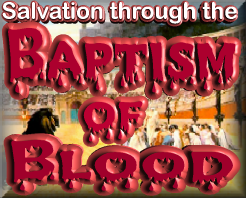 Then Griff gets to the core by producing the shining precedent the Church has sunk her teeth into from earliest times in providing example after example of canonized saints who never had the chance to be baptized by water, yet they are official saints in Heaven. If the good fruit of what the Church says doesn't sink the Feeneyite heresy, then we can only hope the latter will dry up, so dehydrated by the arid audacity of stubborness and pride to dare deny Catholic truth. Griff lays out the irrefutable evidence for Baptism of Blood in his ninth installment, Bobbing for BOB Then Griff gets to the core by producing the shining precedent the Church has sunk her teeth into from earliest times in providing example after example of canonized saints who never had the chance to be baptized by water, yet they are official saints in Heaven. If the good fruit of what the Church says doesn't sink the Feeneyite heresy, then we can only hope the latter will dry up, so dehydrated by the arid audacity of stubborness and pride to dare deny Catholic truth. Griff lays out the irrefutable evidence for Baptism of Blood in his ninth installment, Bobbing for BOB

 While arguments for Baptism of Desire might seem slim compared to Baptism of Blood, there are actually quite a few excellent references if one bothers to research for the full truth among the esteemed Fathers and Doctors of the Church that prove the actuality of Baptism of Desire, and totally refute the heresy of Feeneyism. In this month dedicated to the Holy Souls what better time to remember the countless souls in Purgatory, many there through the Baptism of Desire.
While arguments for Baptism of Desire might seem slim compared to Baptism of Blood, there are actually quite a few excellent references if one bothers to research for the full truth among the esteemed Fathers and Doctors of the Church that prove the actuality of Baptism of Desire, and totally refute the heresy of Feeneyism. In this month dedicated to the Holy Souls what better time to remember the countless souls in Purgatory, many there through the Baptism of Desire.
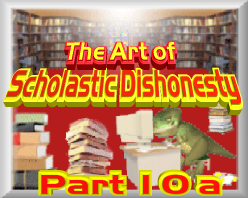  Griff Ruby resumes his mega-part comprehensive series "The Art of Scholastic Dishonesty" in exposing not only the heresy of Feeneyism, but also the intended deliberate dishonest deception of those who have deceived. Throughout the history of the Church no true Authority of the Church has ever ruled against what is called the "Baptism of Desire." While it is true those souls dying without the salvific waters of the Sacrament of Holy Baptism would not be members of the Church Militant,they would be members of the Church Suffering, and a few, such as St. Dismas, members of the Church Triumphant. Thus, in this month of the Holy Souls it is necessary to refute those who harm souls by denying what the Fathers, Doctors, Saints and Popes have accepted and never condemned: BOD. In truly studying the quotes attributed to reliable sources such as Saint Ambrose, for example, one can see unreliable sources not only taking these quotes out of context, but applying an entirely different meaning and presuming they themselves know more than God Himself. It's not only the height of scholastic dishonesty, but sheer stupidity, not to mention very dangerous to their own soul and those whom they mislead. Griff presents the first part of his treatise on BOD with, Fathers Know Best what Desires God Desires
Griff Ruby resumes his mega-part comprehensive series "The Art of Scholastic Dishonesty" in exposing not only the heresy of Feeneyism, but also the intended deliberate dishonest deception of those who have deceived. Throughout the history of the Church no true Authority of the Church has ever ruled against what is called the "Baptism of Desire." While it is true those souls dying without the salvific waters of the Sacrament of Holy Baptism would not be members of the Church Militant,they would be members of the Church Suffering, and a few, such as St. Dismas, members of the Church Triumphant. Thus, in this month of the Holy Souls it is necessary to refute those who harm souls by denying what the Fathers, Doctors, Saints and Popes have accepted and never condemned: BOD. In truly studying the quotes attributed to reliable sources such as Saint Ambrose, for example, one can see unreliable sources not only taking these quotes out of context, but applying an entirely different meaning and presuming they themselves know more than God Himself. It's not only the height of scholastic dishonesty, but sheer stupidity, not to mention very dangerous to their own soul and those whom they mislead. Griff presents the first part of his treatise on BOD with, Fathers Know Best what Desires God Desires
  Griff Ruby continues with the second part of his tenth installment. This series was launched in order to help souls. Thus this second part of the Baptism of Desire is published today, All Souls' Day for there are no doubt countless souls in Purgatory needing our prayers; many of those souls there through the baptism of Desire. While the Dimond Treatise has been well refuted in every aspect throughout this series, another Feeneyite deserves to be grilled on his scholastic dishonesty in deliberately leaving out the context of quotes that sway the reader to think a Father or sage Saint didn't know what he was talking about. Below you can see this in black and white, especially in respect to the respected Doctor of Grace Saint Augustine, and how the desire to defend Feenyeism prompts desperate heretics to not only stretch the truth about Baptism of Desire, but deliberately deceive by omitting the true intention of this holy Doctor of the Church and other Church authorities who have been quoted. In this age of instant gratification, we must remember that holy Mother Church has always deliberated slowly but surely. There are no such things as shortcuts, something evident by providing all the evidence to prove the scholastic dishonesty of Feeneyites. Desire to Know the Full Truth about Baptism of Desire
Griff Ruby continues with the second part of his tenth installment. This series was launched in order to help souls. Thus this second part of the Baptism of Desire is published today, All Souls' Day for there are no doubt countless souls in Purgatory needing our prayers; many of those souls there through the baptism of Desire. While the Dimond Treatise has been well refuted in every aspect throughout this series, another Feeneyite deserves to be grilled on his scholastic dishonesty in deliberately leaving out the context of quotes that sway the reader to think a Father or sage Saint didn't know what he was talking about. Below you can see this in black and white, especially in respect to the respected Doctor of Grace Saint Augustine, and how the desire to defend Feenyeism prompts desperate heretics to not only stretch the truth about Baptism of Desire, but deliberately deceive by omitting the true intention of this holy Doctor of the Church and other Church authorities who have been quoted. In this age of instant gratification, we must remember that holy Mother Church has always deliberated slowly but surely. There are no such things as shortcuts, something evident by providing all the evidence to prove the scholastic dishonesty of Feeneyites. Desire to Know the Full Truth about Baptism of Desire
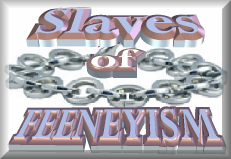
 Stubbornness is a trait born of pride often found in cults who refuse to believe their leader is all wet, totally off track. Such is the case with the cult of Feeneyism entrenched at the St. Benedict Center which was founded by Fr. Feeney as ground zero and carried out in defiance of Eternal Rome's warnings to cease and desist. In their disobedience they ceased being "slaves of Mary" and became slaves of heresy.
Stubbornness is a trait born of pride often found in cults who refuse to believe their leader is all wet, totally off track. Such is the case with the cult of Feeneyism entrenched at the St. Benedict Center which was founded by Fr. Feeney as ground zero and carried out in defiance of Eternal Rome's warnings to cease and desist. In their disobedience they ceased being "slaves of Mary" and became slaves of heresy.
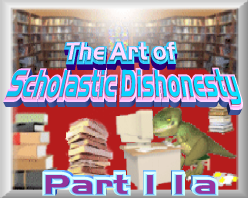 Griff Ruby resumes his mega-part comprehensive series "The Art of Scholastic Dishonesty" as he now focuses on the messenger. Much has been said about the message of Feeneyism and now Griff sets his sights on the messenger who started this heretical mess, one Fr. Leonard Feeney and how he veered from the path that was formerly so promising. That is what happens when cults are formed and given more importance than the Faith itself. One definition of a cult is "zealous devotion to a person, ideal or thing" and that would definitely apply to those who have so stubbornly clung to the heresy of Feeneyism even in the face of what holy Mother Church has decreed. Normally, to prove a case against such a cult those outside the cult would be called upon to provide evidence or bring testimony to refute the defense of said cult, but in this case the evidence from members of the cult themselves easily indicts all those involved within the cult of Feeneyism. The question is are they, and their iconic leader of recent memory, really that stupid or that proud and devious? Griff shows, sadly, that it is the latter as he documents in the first part of installment eleven Conspiracy of a Cult
Griff Ruby resumes his mega-part comprehensive series "The Art of Scholastic Dishonesty" as he now focuses on the messenger. Much has been said about the message of Feeneyism and now Griff sets his sights on the messenger who started this heretical mess, one Fr. Leonard Feeney and how he veered from the path that was formerly so promising. That is what happens when cults are formed and given more importance than the Faith itself. One definition of a cult is "zealous devotion to a person, ideal or thing" and that would definitely apply to those who have so stubbornly clung to the heresy of Feeneyism even in the face of what holy Mother Church has decreed. Normally, to prove a case against such a cult those outside the cult would be called upon to provide evidence or bring testimony to refute the defense of said cult, but in this case the evidence from members of the cult themselves easily indicts all those involved within the cult of Feeneyism. The question is are they, and their iconic leader of recent memory, really that stupid or that proud and devious? Griff shows, sadly, that it is the latter as he documents in the first part of installment eleven Conspiracy of a Cult
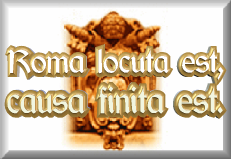
 The tragic journey of a good priest who thought outside the box and, by his stubborn pride, found himself and his followers outside the Church even though ironically that is what he fought so hard to defend, but never to Christ's true Authority on earth.
The tragic journey of a good priest who thought outside the box and, by his stubborn pride, found himself and his followers outside the Church even though ironically that is what he fought so hard to defend, but never to Christ's true Authority on earth.
  Griff Ruby presents the second part of his eleventh installment of his mega-part comprehensive series "The Art of Scholastic Dishonesty." After exposing the cult, Griff now poses the question: What part of "Rome has spoken, the case is closed" didn't Fr. Feeney and his stubborn followers get? The Holy Office gave him every opportunity to state his case, but he cowardly refused, bunkering down with his cult followers at St. Benedict Center, fighting his battles through his tabloid. While he might have won some battles from the rooftops it all proved futile for he lost a war, one he started and was never necessary. Rather than honorable surrender, he went shamefully to the gallows outside the Church. A sad, tragic commentary on a man who ruined his life and the lives of many who even today continue to stubbornly cling to heresy. All Feeney had to do in order to become the good general, the noble soldier of Christ was to submit to the proper and highest authority in Rome when Rome was still the true Authority. Feeney had every opportunity and he shunned Christ and His Church out of pride. Griff chronicles the events and correspondence leading up to Fr. Feeney's excommunication as he documents in the second part of installment eleven The Church vs. Feeneyism
Griff Ruby presents the second part of his eleventh installment of his mega-part comprehensive series "The Art of Scholastic Dishonesty." After exposing the cult, Griff now poses the question: What part of "Rome has spoken, the case is closed" didn't Fr. Feeney and his stubborn followers get? The Holy Office gave him every opportunity to state his case, but he cowardly refused, bunkering down with his cult followers at St. Benedict Center, fighting his battles through his tabloid. While he might have won some battles from the rooftops it all proved futile for he lost a war, one he started and was never necessary. Rather than honorable surrender, he went shamefully to the gallows outside the Church. A sad, tragic commentary on a man who ruined his life and the lives of many who even today continue to stubbornly cling to heresy. All Feeney had to do in order to become the good general, the noble soldier of Christ was to submit to the proper and highest authority in Rome when Rome was still the true Authority. Feeney had every opportunity and he shunned Christ and His Church out of pride. Griff chronicles the events and correspondence leading up to Fr. Feeney's excommunication as he documents in the second part of installment eleven The Church vs. Feeneyism
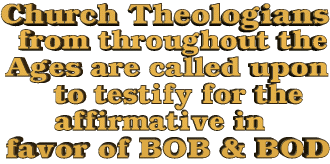
 The Dead Theologians Society are very much alive in their doctrinal accordance and they weigh in with living proof that overwhelmingly favors Baptism of Blood and Baptism of Desire as being in total union with the First Dogma Extra Ecclesiam Nulla Salus.
The Dead Theologians Society are very much alive in their doctrinal accordance and they weigh in with living proof that overwhelmingly favors Baptism of Blood and Baptism of Desire as being in total union with the First Dogma Extra Ecclesiam Nulla Salus.
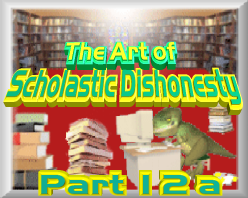 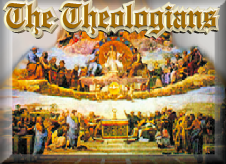
Griff Ruby's mega-part comprehensive series "The Art of Scholastic Dishonesty" has been dedicated to exposing not only the heresy of Feeneyism, but also the intended deliberate dishonest deception of those who have deceived. He has done so for the sake of those who have been deceived. After eleven installments, Griff begins his final three-part installment in refuting Peter Dimond's Treatise which steadfastly defends and promotes Feeneyism. In the first part of his twelfth installment he calls credible Church Theologians to the bench to testify to the overwhelming support for Baptism of Blood and Baptism of Desire. The virtually unanimous consensus of at least twenty-five respected Church theologians sampled over the ages has been consistently in agreement for BOB and BOD and scarcely an opinion breathed, let alone even one identified convincing argument, or any consensus, against Baptism of Blood and/or Baptism of Desire. Thus Griff presents the first of a three part closing argument against the Treatise with Theologians Against Feeneyism and the Treatise

 For long the catechism has been the vehicle for explaining the holy Faith, laying out the tenets in understandable language. No where does the Catechism ever deny Baptism of Blood or Baptism of Desire, thus leaving the Feeneyites with empty pages for their arguments.
For long the catechism has been the vehicle for explaining the holy Faith, laying out the tenets in understandable language. No where does the Catechism ever deny Baptism of Blood or Baptism of Desire, thus leaving the Feeneyites with empty pages for their arguments.
 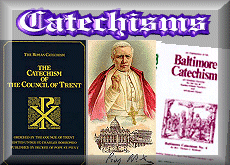
Griff Ruby's mega-part comprehensive series "The Art of Scholastic Dishonesty" has been dedicated to exposing not only the heresy of Feeneyism, but also the intended deliberate dishonest deception of those who have deceived. He has done so for the sake of those who have been deceived. Griff continues his final three-part installment in refuting Peter Dimond's Treatise which steadfastly defends and promotes Feeneyism. In the second part of his twelfth installment the Catechetical tenets are introduced as evidence against the fallacy that Baptism of Blood and Baptism of Desire are heresy. Rather the Catechisms overwhelmingly support BOB and BOD and leave no room for rebuttal for Roma locuta est whether it is The Catechism of Trent, the Catechism of St. Pius X or the Baltimore Catechism to name a few. Thus Griff presents the second of a three part closing argument against the Treatise with The Catechism Against Feeneyism and the Treatise

 The time has arrived to present closing arguments in the case against Feeneyism and the Treatise and Griff is prepared with over one hundred and forty incriminating exhibits that render those accused of scholastic dishonesty guilty as charged.
The time has arrived to present closing arguments in the case against Feeneyism and the Treatise and Griff is prepared with over one hundred and forty incriminating exhibits that render those accused of scholastic dishonesty guilty as charged.
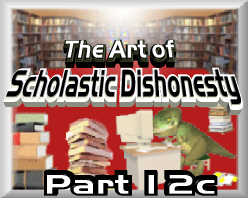 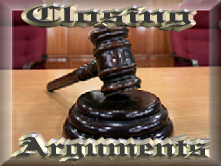
Griff Ruby's mega-part comprehensive series "The Art of Scholastic Dishonesty" has been dedicated to exposing not only the heresy of Feeneyism, but also the intended deliberate dishonest deception of those who have deceived. He has done so for the sake of those who have been deceived. Griff completes his final three-part installment in refuting Peter Dimond's Treatise which steadfastly defends and promotes Feeneyism. . We have now arrived at the closing arguments which clearly, using 112 failsafe evidential examples and proving 30 misquotes by Dimond in his Treatise and others, that these are the final nails in the coffin of Feeneyism. Good Riddance forever more as we let it die in hopes souls do not die believing the lies perpetrated by those exhibiting such blatant scholastic dishonesty. Thus Griff presents the final convincing and irrefutable proof with his Closing Arguments Against Feeneyism and the Treatise
 Feeney's book Bread of Life is not only hard to digest but harmful to the soul.
Feeney's book Bread of Life is not only hard to digest but harmful to the soul.
 Griff resumes the second half of his book, if you will, on totally debunking Feeneyism and taking on others who have used the art of scholastic dishonesty to further their own agenda and mislead readers, leading them away from the true Faith by fostering error and even heresy. In his thirteenth installment, he returns to the source of Feeneyism, the Boston Jesuit Fr. Leonard Feeney who established a cult by denying Baptism of Blood and Baptism of Desire, effectively establishing a Jansenistic position in taking Extra Ecclesiam Nulla Salus to the extreme and sitting in judgment where even saints, Popes and Doctors of the Church never ventured. His hypothesis are not only warped, but wrapped in dishonesty as Griff details in exposing this proud priest who sought to deceive through the art of scholastic dishonesty, particularly in his book which Griff breaks down, Bread of Life. What Feeney has provided is rather molded wheat that cannot be digestible to Catholics for it can be toxic to the soul as he identifies in his thirteenth installment Begin at the Beginning
Griff resumes the second half of his book, if you will, on totally debunking Feeneyism and taking on others who have used the art of scholastic dishonesty to further their own agenda and mislead readers, leading them away from the true Faith by fostering error and even heresy. In his thirteenth installment, he returns to the source of Feeneyism, the Boston Jesuit Fr. Leonard Feeney who established a cult by denying Baptism of Blood and Baptism of Desire, effectively establishing a Jansenistic position in taking Extra Ecclesiam Nulla Salus to the extreme and sitting in judgment where even saints, Popes and Doctors of the Church never ventured. His hypothesis are not only warped, but wrapped in dishonesty as Griff details in exposing this proud priest who sought to deceive through the art of scholastic dishonesty, particularly in his book which Griff breaks down, Bread of Life. What Feeney has provided is rather molded wheat that cannot be digestible to Catholics for it can be toxic to the soul as he identifies in his thirteenth installment Begin at the Beginning
 Reply to A Reply to a Liberal, Part One
Reply to A Reply to a Liberal, Part One
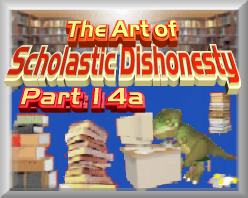 Griff Ruby continues his second round of Feeney refutations by taking apart one of the St. Benedict's Center's very first attempts at defining their position publicly. Though the denials of Baptism of Blood and Desire were only hinted at, the kind of pessimistic thinking upon which those denials were based is fully evidenced. The Reply to a Liberal piece introduction includes the entirety of the very first response the Church ever made to the contentions of the St. Benedict's Center and Fr. Feeney, namely that by Fr. Philip Donnelly, S.J. Mercilessly was Fr. Donnelly attacked, though in fact he said nothing wrong. So at the very least, Fr. Donnelly must be vindicated, in all justice. He was the "first responder," like the first paramedic to arrive on an accident scene, and such an ugly attack was all the thanks he recieved. In this first of three parts, Griff exposes the ignorance and ugly debating tactics of those who hold mere ignorance itself to be sufficient cause for damnation, as he addresses the Introduction, Part 1, and the first several paragraphs of Part 2 of Reply to a Liberal, for this first of a three part response with the beginning of his fourteenth installment of his article Nascent Feeney
Griff Ruby continues his second round of Feeney refutations by taking apart one of the St. Benedict's Center's very first attempts at defining their position publicly. Though the denials of Baptism of Blood and Desire were only hinted at, the kind of pessimistic thinking upon which those denials were based is fully evidenced. The Reply to a Liberal piece introduction includes the entirety of the very first response the Church ever made to the contentions of the St. Benedict's Center and Fr. Feeney, namely that by Fr. Philip Donnelly, S.J. Mercilessly was Fr. Donnelly attacked, though in fact he said nothing wrong. So at the very least, Fr. Donnelly must be vindicated, in all justice. He was the "first responder," like the first paramedic to arrive on an accident scene, and such an ugly attack was all the thanks he recieved. In this first of three parts, Griff exposes the ignorance and ugly debating tactics of those who hold mere ignorance itself to be sufficient cause for damnation, as he addresses the Introduction, Part 1, and the first several paragraphs of Part 2 of Reply to a Liberal, for this first of a three part response with the beginning of his fourteenth installment of his article Nascent Feeney
 Reply to A Reply to a Liberal, Part Two
Reply to A Reply to a Liberal, Part Two
 Griff continues his second round of Feeney refutations with this second part of taking apart one of the St. Benedict's Center's very first attempts at defining their position publicly, a piece titled Reply to a Liberal. For some reason, one significant focus of the Reply to a Liberal piece is not actually Fr. Donnelly himself but another writer by the name of Fr. Jean-Vincent Bainvel, a Jesuit who had written a book titled "Is There Salvation Outside the Catholic Church?" But then Griff takes on an ambiguity that necessarily resides at the center of the controversy. Which is it? Does God condemn the non-culpable or is every non-Catholic under any circumstance personally culpable for their failure to become Catholic? The answer seems to depend upon who one is talking to and when. By trying to claim neither they have instead insinuated both, for at least one of those claims would necessarily be true if the St. Benedict's Center position were the correct one. And what about invincible ignorance? Can it excuse all things, or only some? And what things did the Pope mean when he said that "to probe deeper is criminal"? In this second of three parts, Griff exposes the bigotry of those who hold all non-Catholics personally guilty of heresy, schism, or apostasy, as he addresses the remainder of Part 2 of his article Nascent Feeney
Griff continues his second round of Feeney refutations with this second part of taking apart one of the St. Benedict's Center's very first attempts at defining their position publicly, a piece titled Reply to a Liberal. For some reason, one significant focus of the Reply to a Liberal piece is not actually Fr. Donnelly himself but another writer by the name of Fr. Jean-Vincent Bainvel, a Jesuit who had written a book titled "Is There Salvation Outside the Catholic Church?" But then Griff takes on an ambiguity that necessarily resides at the center of the controversy. Which is it? Does God condemn the non-culpable or is every non-Catholic under any circumstance personally culpable for their failure to become Catholic? The answer seems to depend upon who one is talking to and when. By trying to claim neither they have instead insinuated both, for at least one of those claims would necessarily be true if the St. Benedict's Center position were the correct one. And what about invincible ignorance? Can it excuse all things, or only some? And what things did the Pope mean when he said that "to probe deeper is criminal"? In this second of three parts, Griff exposes the bigotry of those who hold all non-Catholics personally guilty of heresy, schism, or apostasy, as he addresses the remainder of Part 2 of his article Nascent Feeney
 Reply to A Reply to a Liberal, Part Three
Reply to A Reply to a Liberal, Part Three
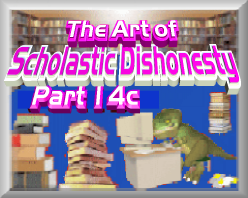 Griff completes his analysis of Reply to a Liberal, taking on its Part 3 and Conclusion. It is in this third part of the Reply to a Liberal piece that baptism itself is directly addressed. And though BOB is grudgingly tolerated (only in the rarest of cases), BOD gets reduced to something short of what is needed for salvation in this first distinction between being justified and being saved if one dies in that condition. Instead of imitating Christ Who seeks to save all by whatever means the Son of God may choose (even if we mortals cannot guess them as we are so wont to do), the Reply to a Liberal piece instead seeks to find and multiply all the possible reasons for a person to be damned. Get the idea that perhaps they don't want too much company in Heaven? Even the innocent can be damned, by their reasoning! And what of those who preferred to be martyred instead of compromising so as to be spared and then offered an opportunity for water Baptism? It claims they were damned! At the very least, that would be news to St. Augustine, who knew some of these martyrs personally. Griff explains in his final part of his three-part installment of his article Nascent Feeney
Griff completes his analysis of Reply to a Liberal, taking on its Part 3 and Conclusion. It is in this third part of the Reply to a Liberal piece that baptism itself is directly addressed. And though BOB is grudgingly tolerated (only in the rarest of cases), BOD gets reduced to something short of what is needed for salvation in this first distinction between being justified and being saved if one dies in that condition. Instead of imitating Christ Who seeks to save all by whatever means the Son of God may choose (even if we mortals cannot guess them as we are so wont to do), the Reply to a Liberal piece instead seeks to find and multiply all the possible reasons for a person to be damned. Get the idea that perhaps they don't want too much company in Heaven? Even the innocent can be damned, by their reasoning! And what of those who preferred to be martyred instead of compromising so as to be spared and then offered an opportunity for water Baptism? It claims they were damned! At the very least, that would be news to St. Augustine, who knew some of these martyrs personally. Griff explains in his final part of his three-part installment of his article Nascent Feeney
 Honesty from Feeneyites? Not a chance because, well, that's all she wrote!
Honesty from Feeneyites? Not a chance because, well, that's all she wrote!
 Resuming this series after a four months-to-the-day hiatus, we can see that for the Feeneyites it is all or nothing and because of their narrow, stubborn stance they are left with nothing. Griff unravels the arguments of such Feeney 'luminaries' as Catherine Goddard Clarke and Thomas Mary Sennot again with precision as he exposes the scholastic dishonesty exhibited by those so desperate to defend Feeneyism to the point of downright deception. At St. Benedict Center it continues to be a blind alley with the blind leading the blind. While many are out of sight, they're also out of their mind to dismiss the Council of Trent's ruling and the Pope's decree of excommunication. They pick and choose what they want, then stretch the truth to try to justify their actions. Time and time again, the followers of Fr. Feeney claim validity to their unique teaching on the basis of the claim that they reconciled to the Church. Griff Ruby gently but firmly dismantles that claim by showing the acceptance of certain groups of Feeney followers to have been purely a "Pastoral" move and quite clearly with no acceptance of their doctrine. They might fool a few, but in the end they can't fool God as Griff proves in his 15th instalment They Fought the Bad Fight
Resuming this series after a four months-to-the-day hiatus, we can see that for the Feeneyites it is all or nothing and because of their narrow, stubborn stance they are left with nothing. Griff unravels the arguments of such Feeney 'luminaries' as Catherine Goddard Clarke and Thomas Mary Sennot again with precision as he exposes the scholastic dishonesty exhibited by those so desperate to defend Feeneyism to the point of downright deception. At St. Benedict Center it continues to be a blind alley with the blind leading the blind. While many are out of sight, they're also out of their mind to dismiss the Council of Trent's ruling and the Pope's decree of excommunication. They pick and choose what they want, then stretch the truth to try to justify their actions. Time and time again, the followers of Fr. Feeney claim validity to their unique teaching on the basis of the claim that they reconciled to the Church. Griff Ruby gently but firmly dismantles that claim by showing the acceptance of certain groups of Feeney followers to have been purely a "Pastoral" move and quite clearly with no acceptance of their doctrine. They might fool a few, but in the end they can't fool God as Griff proves in his 15th instalment They Fought the Bad Fight
|



























